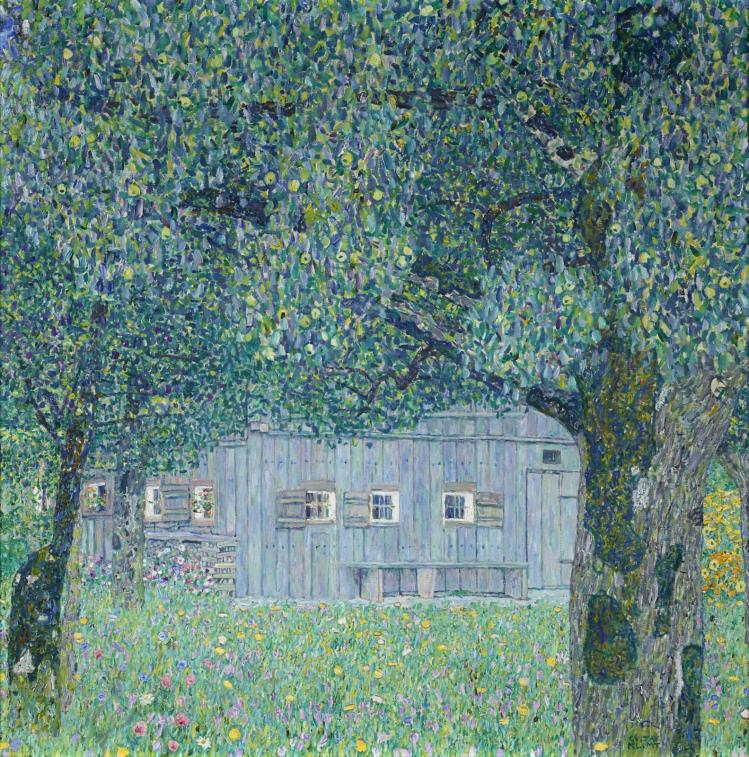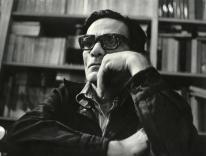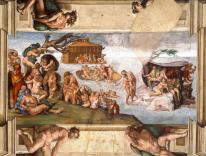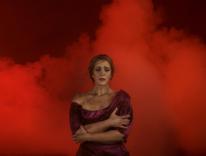
Few modern artists are so endlessly pretty as Gustav Klimt. In the paintings of this fin de siècle Austrian, a woman’s skin is always luminous, her cheeks forever rosy, her plump body drowning in diaphanous silks and richly patterned robes. His compositions are bright, bold, and flat, all gold leaf and flowers, their outlines easy to read in reproduction. Has any work been printed on so many tote bags or been thumbtacked in so many dorm rooms as The Kiss? Klimt’s paintings seem ready-made for decoration, and are for that reason readily dismissed.
Get yourself in a room with one of these paintings, though, and its gorgeous over-muchness—all that delicate skin and gleaming gold and dense textural diversity—will drag you in, revealing a subtle wealth of detail. Not pretty, no; beautiful. This is certainly true in his landscapes, currently the subject of an underwhelming exhibition at New York’s Neue Galerie. Seen from a distance or printed in a book, they become a welter of repetitive strokes in which bushes, canopies, lawns, and garden beds melt into one another, generating a warm green blur in your mind, certainly the lesser part of his oeuvre. In person, Klimt’s landscapes are spaces of exquisite abundance: rich blooming expanses adorned with pointillist arrays of fruit and flowers, gardens whose curtains of foliage are as flat and impenetrable as the backdrop in a theater. He subordinates nature to his grand aesthetic vision.
Klimt was born in 1862, the eldest son of a gold engraver and a musician manquée. He studied at the Vienna school of applied arts and crafts, a decorative education that gives many of his works their iconic qualities. His artistic life was one of continual transition, beginning with the era’s dull academic classicism and moving quickly through symbolism, impressionism, japonisme, and more. Klimt’s Landscapes begins with some of his earliest works, which feel like the output of an unrelated and far less inspired artist. These include a pair of dully accomplished allegories from the 1880s, which show classical figures adrift in darkly realistic forests. His decorations for Vienna’s Burgtheater and Kunsthistorisches Museum are more accomplished, finely illustrating all the trappings of an imagined antiquity. But there is no life in them; they trap the energy of his obsessions under thick layers of technique.
Klimt’s canonical status belies what a poor fit he was for the establishment of his day. His monumental paintings for the Vienna Faculty were denounced as pornographic and survive only as photographs. In 1897, Klimt and his colleagues founded the Vienna Secession in opposition to the official Society of Vienna Artists, which many younger artists considered stuffy and exclusive. In the first issue of the Vienna Secession’s literary magazine Ver Sacrum (“The Sacred Spring”), the critic Hermann Bahr wrote: “The choice between commerce and art is the issue at stake in our Secession. It is not a debate over aesthetics, but a confrontation between two different spiritual states.”
The aim was a fusion of multiple art forms—painting, sculpture, architecture, literature, and design—into one holistic vision: the total artwork, or Gesamstkunstwerk. Such a work would require the harmony of diverse subjects and forms within a single expansive artistic project. Ver Sacrum published stories by international modernists like Knut Hamsun alongside reproductions of Secessionist artworks. Klimt served as the first president of the Vienna Secession, and his background in design served the new group well: he designed their exhibition posters, and painted a grand frieze for Joseph Maria Olbrich’s Secession Building, a grand Grecian temple crowned with a golden dome.
Klimt’s bold Beethoven Frieze is a good illustration of the powerful tensions at work in the Secession. Painted in a fluid, sketchy style, the work brims with a youthful enthusiasm for new styles and possibilities, deploying the simplified forms of illustration and graphic design to transform human bodies into decoration: they drift, float, and congregate, liquid and light, a million miles away from his earlier work for the Burgtheater, with its leaden imitations of Greek antiquity. Yet these figures of the Beethoven Frieze are also classical in their way. The Secession artists took Athena for their patron symbol, and Klimt’s poster for their first exhibition was topped by an illustration of Theseus slaying the Minotaur. In seeking artistically novel means of illustrating ancient themes, Klimt and his compatriots in Vienna, Hamburg, Berlin, and elsewhere anticipated Ezra Pound’s command to “make it new”—to construct the future from the materials of the past.
Klimt’s best works are all about precisely calibrated tensions. In a painting on display on the Neue Galerie’s second floor, the creamy skin of Adele Bloch-Bauer stands out against her dress of thickly encrusted gold. Inspired by Japanese woodcuts and Orthodox icons, the persistent flatness of Klimt’s work allows him to place competing textures within the same frame, juxtaposing the delicately blended reflections on the surface of a lake, for example, with the trees and buildings on the shore, which he renders with thick daubs of paint. In Kammer Castle on Lake Attersee I, the style actually advances at the waterline: impressionism below, expressionism above. I experienced a kind of whiplash as my eyes leapt between the two.
Klimt painted his landscapes on and around the Attersee, a lake near Salzburg where he took his annual Sommerfrisch. They are images of real places, yet they are as sublimely false as his allegories, as richly artificial as his portraits. His tree trunks are so thin and fragile that they hardly seem able to hold up their fertile, fruitful canopies. In the exhibition’s best loans, The Park and Pear Trees, Klimt gazes upward into great pointillist blocks of greenery where one canopy blends seamlessly with another. The images are both abstract and illustrative, like one of the postcards produced by his colleagues at the Wiener Werkstätte. This flattened perspective turns every building into a little model, a flimsy construction tenuously nestled within a billowing natural world. In one of my favorite paintings, the Upper Austrian Farmhouse actually seems pasted into its space in the pear orchard, a small set of vertical boards hesitantly shimmering inside all the circles formed by leaves, pears, flowers, and stalks.
That particular painting isn’t on view at the Neue Galerie; nor are any of his dramatic garden views, whose heavy-headed sunflowers droop like tragic heroes. In fact, Landscapes has a mere seven landscape paintings on display, two of which are part of the Galerie’s permanent collection. Most of the exhibit’s four rooms are given over to photographs, posters, early paintings, drawings, several issues of Ver Sacrum, one unfinished portrait (also from the permanent collection), and twenty-seven prints from a rare collection of Klimt’s complete works. There is even a digital slideshow of Attersee photographs taken during Klimt’s lifetime.
They all provide insight into his early years, his relationship with the fashion designer Emilie Flöge, the places where he painted, and his very modern affection for decoration and reproduction. But they do not do much to help us understand how Klimt saw the natural world, and they tell us almost nothing about the important relationship between his landscapes and his portraits. There are so few outdoor scenes and so many prints that I had to wonder whether a series of more ambitious loans fell through, so that the curators had to fill in the gaps with images from their own permanent collection. The result is an exhibition stuck somewhere between an overview of the artist’s career and an argument for a neglected aspect of his oeuvre. In short, it lacks cohesion.
While Klimt was painting the natural world as an interlocking set of gleaming tiles, his contemporaries—whose work is on display downstairs—were transforming the landscape into far more radical images. The cubist Lyonel Feininger’s Blue Cloud renders a grand vista in a handful of richly simplified shapes, subordinating land and sea, cloud and shadow to the same set of clear geometric principles. Expressionists like Erich Heckel and Karl Schmidt-Rottluff saw nature as something madly energized—a swaying, rushing, overblooming riot of color and texture. Their canopies of their trees blur; their roots wiggle their way up out of the ground; the whole landscape seems to writhe. Klimt’s landscapes feel so restrained by comparison.
Yet his paintings need that restraint, the accomplished classicism that he holds in tension with everything vivid, life-giving, and physical in his paintings. Klimt’s affinity for decoration has made his work into something easy to reproduce but hard to properly appreciate. To borrow a phrase from Walter Benjamin, Klimt’s mystical work has lost the greater part of its mystique; the imperatives of commerce have long since won out over those of the art. The photograph, the print, the jpeg irons the tension out of his textures, dims the blood blooming in all those soft feminine cheeks, makes The Kiss mundane, generic, memeable. Without the physical object, there is no tension, no edge to take hold of, nothing that allows you to pierce the surface of the paintings and access the deeper state that gave rise to them in the first place. It’s all just decoration now: easy to take in, and even easier to ignore.
Please email comments to [email protected] and join the conversation on our Facebook page.
Share
Previous Story
A New Era in Poland?
Next Story
Whither the University?


